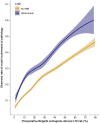Diagnostic Value, Oncologic Outcomes, and Safety Profile of Image-Guided Surgery Technologies During Robot-Assisted Lymph Node Dissection with Sentinel Node Biopsy for Prostate Cancer
- PMID: 33547208
- PMCID: PMC8724888
- DOI: 10.2967/jnumed.120.259788
Diagnostic Value, Oncologic Outcomes, and Safety Profile of Image-Guided Surgery Technologies During Robot-Assisted Lymph Node Dissection with Sentinel Node Biopsy for Prostate Cancer
Abstract
Despite good sensitivity and a good negative predictive value, the implementation of sentinel node biopsy (SNB) in robot-assisted radical prostatectomy with extended pelvic lymph node dissection (ePLND) for prostate cancer is still controversial. For this reason, we aimed to define the added value of SNB (with different tracer modalities) to ePLND in the identification of nodal metastases. Complication rates and oncologic outcomes were also assessed. Methods: From January 2006 to December 2019, prospectively collected data were retrospectively analyzed from a single-institution database regarding prostate cancer patients treated with robot-assisted radical prostatectomy and ePLND with or without additional use of SNB, either with the hybrid tracer indocyanine green (ICG)-99mTc-nanocolloid or with free ICG. Multivariable logistic and Cox regression models tested the impact of adding SNB (either with the hybrid tracer or with free ICG) on lymph nodal invasion detection, complications, and oncologic outcomes. Results: Overall, 1,680 patients were included in the final analysis: 1,168 (69.5%) in the non-SNB group, 161 (9.6%) in the ICG-SNB group, and 351 (20.9%) in the hybrid-SNB group. The hybrid-SNB group (odds ratio, 1.61; 95%CI, 1.18-2.20; P = 0.002) was an independent predictor of nodal involvement, whereas the ICG-SNB group did not reach independent predictor status when compared with the non-SNB group (odds ratio, 1.35; 95%CI, 0.89-2.03; P = 0.1). SNB techniques were not associated with higher rates of complications. Lastly, use of hybrid SNB was associated with lower rates of biochemical recurrence (0.79; 95%CI, 0.63-0.98) and of clinical recurrence (hazard ratio, 0.76, P = 0.035) than were seen in the non-SNB group. Conclusion: The implementation of hybrid-SNB technique with ICG-99mTc-nanocolloid in prostate cancer improves detection of positive nodes and potentially lowers recurrence rates with subsequent optimization of patient management, without harming patient safety.
Keywords: fluorescence; image-guided surgery; indocyanine green; lymph node dissection; prostate cancer; sentinel node biopsy.
© 2021 by the Society of Nuclear Medicine and Molecular Imaging.
Figures




References
-
- Fossati N, Willemse PPM, Van den Broeck T, et al. . The benefits and harms of different extents of lymph node dissection during radical prostatectomy for prostate cancer: a systematic review. Eur Urol. 2017;72:84–109. - PubMed
-
- Mottet N, van den Bergh RCN, Briers E, et al. . EAU-EANM-ESTRO-ESUR-SIOG guidelines on prostate cancer—2020 update. Part 1: screening, diagnosis, and local treatment with curative intent. Eur Urol. 2021;79:243–262. - PubMed
-
- Harke NN, Godes M, Wagner C, et al. . Fluorescence-supported lymphography and extended pelvic lymph node dissection in robot-assisted radical prostatectomy: a prospective, randomized trial. World J Urol. 2018;36:1817–1823. - PubMed
-
- Wit EMK, Acar C, Grivas N, et al. . Sentinel node procedure in prostate cancer: a systematic review to assess diagnostic accuracy. Eur Urol. 2017;71:596–605. - PubMed
-
- Grivas N, Wit EMK, Kuusk T, et al. . The impact of adding sentinel node biopsy to extended pelvic lymph node dissection on biochemical recurrence in prostate cancer patients treated with robot-assisted radical prostatectomy. J Nucl Med. 2018;59:204–209. - PubMed
Publication types
MeSH terms
LinkOut - more resources
Full Text Sources
Other Literature Sources
Medical
